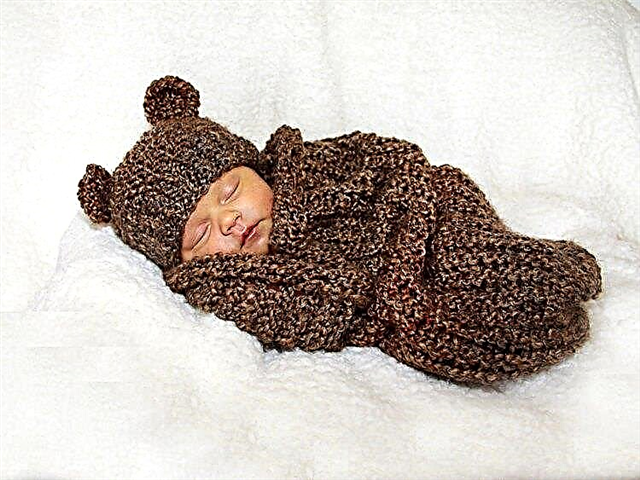Every woman, seeing her newborn child for the first time, tries to make sure that everything is in order with him, and is very upset when she notices the unusual shape of the head: when the back of the head is flat and the skull of the child is asymmetrical. Parental experiences are understandable, so doctors explain why babies have an uneven head.

Parents are worried if the shape of the head of the newborn does not meet the standard indicators
What does the skull of a newborn look like?
The anatomy of newborns is such that immediately after birth, they may have an unusual skull appearance. In pediatrics, it is considered: what was the method of birth, so will the head: elongated, flattened or even.In order not to worry once again, you need to know why this is the norm:
- The baby's skull has soft bones;
- They are mobile, during birth there is their self-imposition, facilitating the movement of the child through the birth canal;
- With the natural process of childbirth, the child's skull is elongated, with a cesarean section - even.
Important! When characterizing the baby's head, it is noted that it is disproportionate to the body, so it looks disproportionately large. This is the difference between the proportions of the body of an infant and an adult.
In addition, the baby's head appears to be disproportionate due to the fact that its circumference is about 2 cm larger than the size of the chest. This is considered an age-related feature of the skull of a newborn baby and an indicator of its health.
The pediatrician monitors the dynamics of development, comparing the indicators according to the anthropometric table.
Changes in the baby's skull during childbirth
During childbirth, it hurts not only the mother, but also the newborn, as he has to push the soft tissues with his head. At this moment, enormous pressure comes on her, deforming her and causing swelling.
Bone mobility during childbirth plays an important role, therefore, changing the baby's skull during childbirth is a physiological necessity.
Deformation of the skull in a newborn
It is the mobility of the bones that allows them to be connected, protecting the child's head from injury and helping to move along the birth canal. The shape of the skull of a newborn child depends on the structure of the mother's birth canal and it happens:
- brachycephalic - in Caesarean children, that is, round, with clearly visible frontal tubercles;
- elongated-oval, that is, dolichocephalic - in babies born naturally.
Due to the difficulties of passing through the mother's pathway, the baby may be born with an asymmetry of the head, sometimes with a cephalohematoma. Deformation of the skull in infants, to a greater extent, is caused by this reason.

Within a few months, the shape of the newborn's skull returns to normal.
Immediately after birth, the skull of the newborn is elongated in the front and back areas, after a few months it increases in the transverse section, and the shape of the head takes on the usual appearance. Normally, the size of a newborn's head is about 36 cm.
Not dangerous if the size is larger. Sometimes this feature the baby inherits from its parents, with age, everything returns to normal. Indicators less than normal are found in premature babies, in children with compression, Down syndrome.
Deviations from the norm
The main reason for deviations from the norm is birth trauma and congenital diseases. Trauma can occur if the head of the fetus does not match the size of the mother's pathways, or she suffers from diabetes. Many consequences can now be cured and the head can be straightened by a year.
Note! Any deviations from the norm frighten adults, they do not know what to do. Doctors reassure: as long as the fontanel is not ossified, all flaws can even out on their own.
Skull pathologies
It is much more difficult to cure congenital diseases, for example, hydrocephalus or dropsy of the brain, which is a serious and dangerous disease. A symptom of another rare pathology, microcephaly, is a too small head, which indicates an underdevelopment of the brain.
You can detect such problems even during pregnancy, with an x-ray, then start treatment.There is also a pathological deformity of the head in a child:
- oblique and asymmetrical occiput - plagiocephaly;
- acrocephaly or elongated form;
- curvature of the frontal or occipital areas - scaphocephaly.
Skull asymmetry in children can lead to neurological pathologies and mental and physical developmental delays.

The size of the newborn's head must meet certain parameters.
What is fontanelle
The fontanelle is the formation between the bones where they should connect to each other. The drawing of the baby's skull is represented by a large number of bones, between them there are open seams, which close from the age of three months:
- The fontanelles are usually closed on the side in full-term babies;
- Posteriorly, the fontanelle is located at the level of the occipital parietal bones, is open in about a quarter of newborns and closes no later than eight weeks;
- From above, the large fontanelle is located at the junction of the crown and longitudinal sutures, has various sizes, the measurement scheme is from 3x3 cm to 1.5x2 cm.
Important! According to the standards, the overgrowth of the fontanel from above occurs up to one and a half years. Its rapid closure indicates an excess of calcium. Slower closure with a flattening of the occiput and an increase in the parietal tubercles may indicate rickets.
The timing of the overgrowth of the fontanelle is an important diagnostic sign; in the presence of violations, a pediatrician consultation is needed, who will refer the child to a neurologist.
Change in the shape of the head in newborns
Parents often ask how long it will take for a child's uneven head to begin to level out. Experts explain that this process can take up to a year. To help the child bounce back faster, parents must follow the rules of caring for him.
Impact of improper care
Sometimes during childbirth, the shape of the head does not suffer, but the mother's wrong actions can harm the baby:
- The elongated and sloping back of the head is a consequence of the incorrect position of the crumbs lying on the back most of the time;
- A flat nape indicates rickets, which means that additional intake of calcium and vitamin D is needed, a change in the diet of a nursing mother;
- When the fontanelle is open, the child should be gently washed, trying not to let water jets fall on him.

A baby's head with an open fontanelle requires great care when leaving
Note! Long lying on the right or left side can cause deformation of the cranial bones, that is, torticollis. This pathology leads to a crooked, tilted position of the head, which is accompanied by anomalies in the development of the spine.
What not to do to reshape the head
Some mums use home massage, that is, "rolling out", to straighten the shape of the baby's head. It is carried out in a circular motion clockwise while pressing on uneven areas.
However, pediatricians believe that such a massage is useful only if it is done by a specialist, in the absence of experience it is better not to risk it. Too much pressure on the bulge of the skull can further increase the deformation.
Note. In most cases, by the age of one year, the child's head takes on those outlines that are laid down at the genetic level.
Examination of the child by a neurologist
During the first month, the asymmetry of the skull can be noticed by parents or a pediatrician at a routine examination, who will give a referral to a neurologist. In difficult cases, it is necessary to consult a neurosurgeon.
The first time you need to visit a neurologist is when you are a little over a month old. The main task of a specialist is to correctly diagnose pathology, preventing the formation of a disease. An experienced doctor will determine what are the abnormalities in the circumference and girth of the head. Up to a year, visits to a neurologist are scheduled every 3 months.
Asymmetry treatment
Pediatricians say that untimely correction of the asymmetry of the head can lead to undesirable consequences in the form of strabismus, curvature of the nasal septum, malocclusion and many others. Therefore, they recommend both special treatment and home measures on how to correct the deformation of the skull in infants:
- Change the baby's headboard more often;
- Breastfeed from different sides;
- Support the head with a roller, not allowing it to fall on its side or back;
- Constantly take the baby in your arms in an upright position.
It is useful to purchase an orthopedic pillow for newborns. Experienced parents claim that it helps to align the child's head.

An orthopedic pillow will help to form an even skull for the baby
A child's uneven skull does not affect the formation of other functions. The shape of the baby's skull is gradually leveled out and reaches its usual appearance, you only need to pass all preventive examinations in a timely manner up to a year.



